Your Beginner’s Guide To Keeping LPS Corals
LPS (Large Polyped Stony) corals are some of the true wonders of the marine environment, from huge Brain Coral Colonies to vast gardens of Euphyllia and Goniopora, these corals build our planet’s reefs in style, and you too can build your own LPS Coral reef with these simple tips. Moving on from Soft Corals to Hard Corals can be daunting for some, but with most LPS Corals, hard doesn’t have to mean difficult, there are a few simple things you can do to ensure these corals thrive in your tank, and we will outline the basics of LPS coral anatomy, reef chemistry and care requirements below
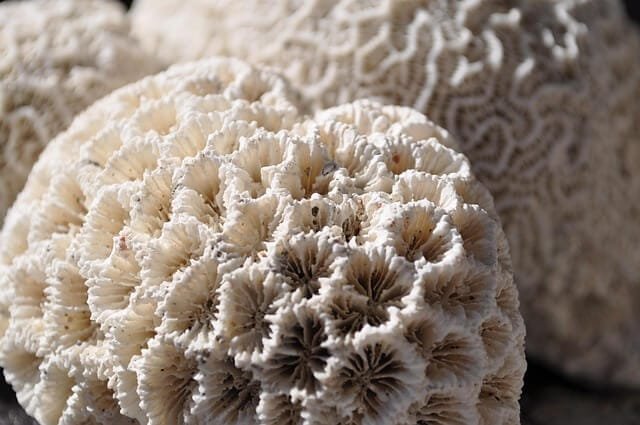
Anatomy Of LPS Corals
A Large Polyped Stony Corals, like all corals, consist of a collection of animals called polyps, but differentiate themselves from Soft Corals by their skeletal structure. Whereas a Soft Coral has little or no skeleton, Hard Corals such as LPS grow out from basal plates, which each polyp deposits in the form of Aragonite (Calcium Carbonate) from the tissue at the base. As each Polyp Grows, more Aragonite is deposited and the skeleton grows thicker and longer. All LPS polyps are ringed by stinging tentacles, which they use to capture food from the water column. This food is then dragged into an oral disc at the centre (the polyp’s mouth) and then finally to the stomach where food is digested.
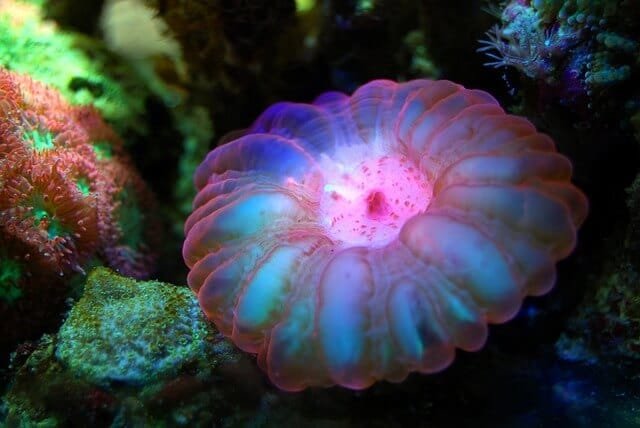
Photosynthesis in LPS Corals
Most LPS corals are partially photosynthetic, that is, they form a symbiotic relationship with a species of dinoflagellate algae called Zooxanthellae, which live in the coral tissues. The coral then feeds on the sugars produced by this algae during photosynthesis, and gets its remaining nutrients from captured food. Some corals have more Zooxanthellae than others, and need more or less light depending, but more on that later.
Some LPS corals, such as the Sun Coral (Tubastrea sp.) are entirely non-photosynthetic, possessing no Zooxanthellae and relying entirely on captured food for sustenance; they can be a challenge to keep, but are strikingly beautiful.
Care Of LPS Corals
As with all corals, good water quality, good flow and good lighting are essential for long term health. Weekly water changes of 10-20% are recommended along with good protein skimming and cleaning. However, Hard Corals also require stability not only in salinity and nutrient levels, but in essential parameters for skeletal growth, known as reef foundation parameters.
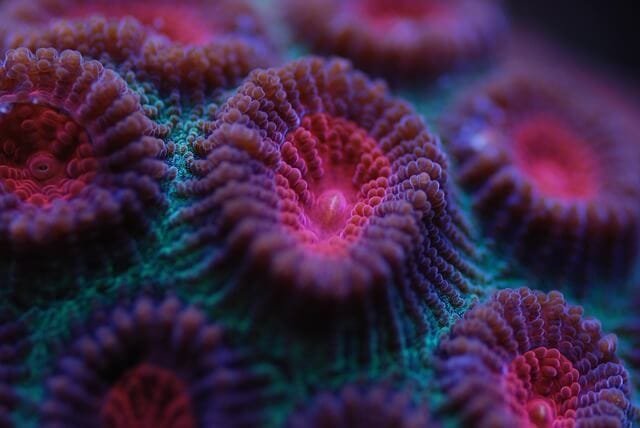
Reef Foundations
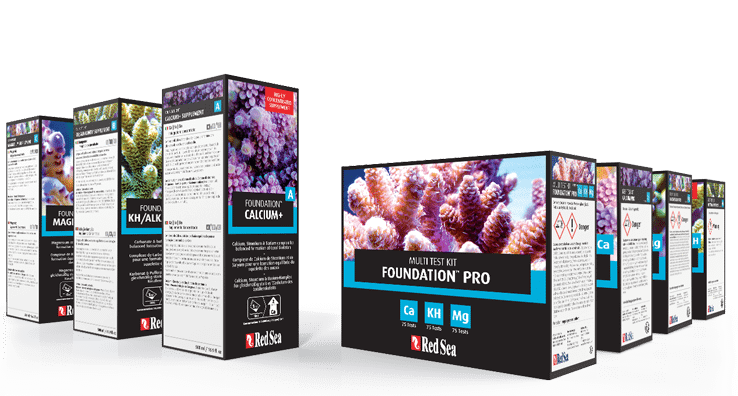
Many chemical elements have an important role in reef chemistry, and there are a few that have a very significant role in skeletal growth, as well as overall health. The three pillars of success with Hard Corals, the three reef foundations: calcium (Ca), magnesium (Mg) and bicarbonates (HCO3) are essential to maintaining good, stable water chemistry, and for supporting the biological processes that sustain both the corals and their colours. These elements, along with many others, are the foundation of all coral reefs globally.
The complex elemental chemistry involved in building coral skeletons and colouring is both fascinating and essential to the health of all coral reefs globally, but in the aquarium keeping hobby it is often looked upon by many as too challenging to maintain. For a tank dominated by SPS (Small Polyped Stony) corals such as Acropora, replenishing depleted elements can be a challenge, as these are by far the fastest growing Hard corals of all, however, many LPS corals are slow growers, so will deplete essential elements more slowly.
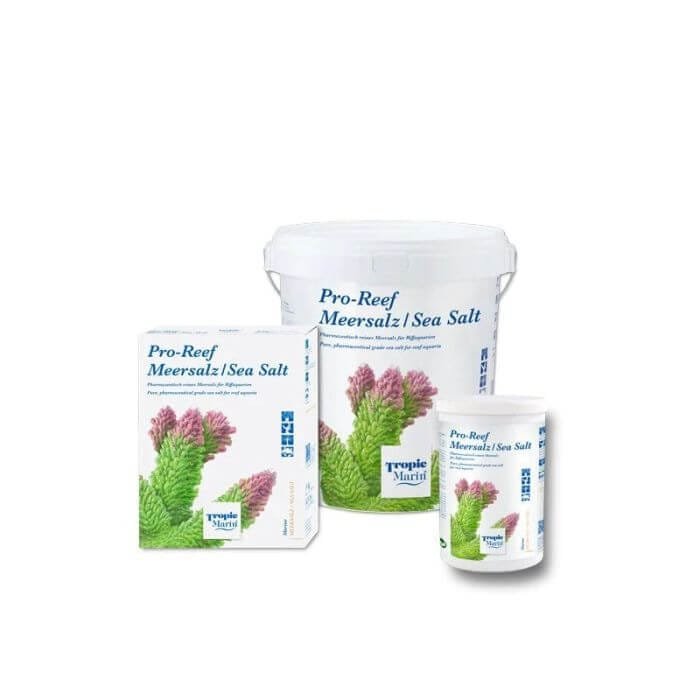
Maintaining Reef Foundations For LPS Corals
For a tank with only a few LPS Corals, levels of essential elements can usually be maintained by weekly water changes and good maintenance practice. For more LPS corals, you will need to test the levels of Calcium, Magnesium and Alkalinity in the tank at least once a week. A calcium level between 420-450, a Magnesium level of 1350-1450 and an alkalinity of 8-10 DKH is considered the standard optimum for most tanks, however this leads me onto an important point, never attempt to change parameters by dosing reef foundations too quickly.
It is very easy to chase numbers and overcompensate, and exceeding the daily dose of each element can usually end up in stressed or dead corals. For instance, if the Magnesium level is low, the Calcium and Alkalinity will also be low, as it is the Magnesium that increases the availability of Calcium and Carbonate ions in the water. As such, aim for an optimal Magnesium level first (no more than 60ppm daily) and then slowly adjust Alkalinity levels to optimum (no more than 0.5 DKH daily), then slowly optimise the Calcium level (no more than 20ppm daily).
To dose a tank for reef foundations, there are many additives that can be used. Brands such as Red Sea and Quantum offer many solutions for maintaining water chemistry, but as with any additive, follow the instructions and do not exceed the daily dose for your size tank. For exceptionally large tanks, the addition of a Calcium Reactor can be beneficial.
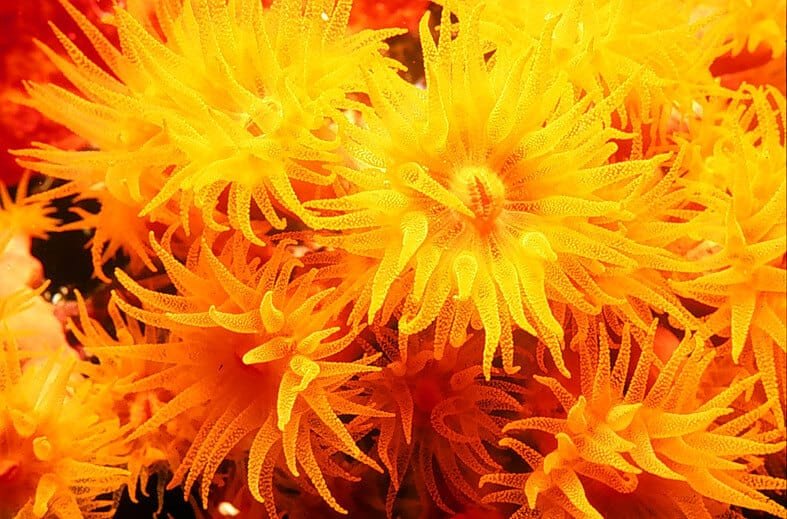
Feeding LPS Corals
Many LPS corals are avid and voracious feeders, readily accepting live, frozen and pellet foods target fed to each polyp. Feeding corals will help maintain excellent health, growth and colour, but remember not to overfeed, as this can pollute the tank. Some LPS corals such as Brain Corals naturally extend their tentacles at night to capture food, but all can be acclimated to accept food during the day. Experiment to find acceptable foods, and turn off pumps and powerheads during feedings as this will prevent food being blown off the corals.
Non-Photosynthetic LPS corals such as sun corals require target feeding a few times a week to survive, Isolating the coral with a holed bucket or a cut coke bottle can be very effective at encouraging these corals to feed.
Related Article: Grubs Up, Your Brief Guide To Feeding Corals
Selection, Handling and Tank Placement
All Hard corals possess delicate flesh and skeletons which can be easily damaged if mishandled. Always pick up an LPS coral from its base and avoid putting any pressure on the coral’s flesh. As a general rule, place all Hard Corals flesh up with the base on a sand bed or flat surface wherever possible. For small frags, attaching the base to live rock with Milliput or coral glue can keep the colony in place.
Once positioned ensure the coral is secure, not positioned too close to any neighbours and avoid overexposure to light or excessive flow; the vast majority of LPS corals prefer low to medium flow and low to medium light.
Many LPS corals can be exceedingly aggressive towards neighbouring corals that get too close, and can react pretty strongly to perceived threats. Some species can extent long tentacles packed with stinging cells, called sweeper tentacles, which can be up to 6 inches long in some species, and will sting any coral unfortunate enough to be too close. In extreme cases, LPS corals can extend their guts in the form of mesenterial filaments, which literally digest nearby competitors alive.
To avoid aggression, select LPS corals with growth and expansion in mind, and ensure each coral has plenty of room to expand fully when open. For most a few inches is fine, but others such as Elegance Corals can inflate their flesh to as much as four times the size of the skeletal base; ensure that coral extension is always taken into account. Many LPS corals will tolerate members of their own species, and can be kept in close gardens with others of their kind, corals of the genus Euphyllia are a wonderful example of this.
Growth, Reproduction and Propagation
Related Blog: The Ultimate Guide to Vibrant Corals – Part 7 – Coral Propagation
As with Soft Corals, all Hard Corals reproduce sexually through an event called spawning, co-ordinated on the lunar cycle; modern tank lighting has replicated the lunar cycle and spawning has been observed in captivity, commonly among LPS corals.
Many LPS corals share nutrients between polyps via a common flesh envelope, as the coral grows, new heads will develop within the flesh which will then lay down their own skeletal bases. Those without common flesh envelopes such as Sun Corals and Euphyllia, will produce new heads by budding from the base of the polyps. Both these types of Corals can be propagated by a process called fragmentation (fragging), which is usually accomplished with the use of delicate tools such as a specialist bandsaw, and then immersed in a healing coral dip. If done carefully, cuttings heal readily and go on to form their own colonies.
Some species of LPS coral such as Goniopora also propagate through budding, where part of the colony exhibits a tumor-like growth which then breaks off and forms a new colony. Others such as Fungia plate corals, consist of single polyp colonies which split apart at the end of their lives, producing many daughter polyps which break off from the old base.
Conclusion
Moving on from Soft Corals to Hard Corals can be daunting, but with Large Polyped Stony (LPS) Corals, its not such a big step up with the right setup and preparation. The old saying of keeping water and not fish matters a lot more for LPS than Soft Corals, but the reward is a truly endless variety of colours and shapes, spectacular gardens laden with colourful tentacles and massive sand bed showpieces. By taking up the challenge and fully embracing the reef aquarium keeping hobby, you will have a true living, growing coral reef in your own home.
Related Blogs:

